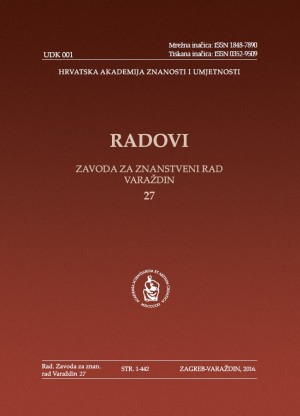Matematika i fizika u Varaždinskom Isusovačkom kolegiju
Mathematics and Physics in Varaždin Jesuit college
Author(s): Stanislav JužničSubject(s): Christian Theology and Religion, Religion and science
Published by: Hrvatska akademija znanosti i umjetnosti - Zavod za znanstveni rad Varaždin
Keywords: Varaždin; Ruđer Bošković; Jesuits; 17th-18th Century; History of Physics and Mathematical Sciences;
Summary/Abstract: For the frst time we provide complete statistics of all professors of physics and mathematics who were working on other functions in the Jesuit Volloege of Varaždin. The statistics include information about their birth, ordination, death, studies, work in Varaždin, mathematical and physical chairs held, missionary work, areas of writing with sub-fields of physics and mathematics, the number of their works in physics mathematics, all preserved works, manuscripts, evaluation of the relevance of their work, and area of operation compared to the mainstream of the then physics-mathematics of Ch. Clavius to Bošković. The relevancy is evaluated by the number and quality of written works, professorial functions, eventual noble birth, high dignities, and missionary work in distant lands. The area of work of particular Jesuit has been allocated to the area of work of professor who headed his eventual mathematical specialization, or his professor of mathematics and physics in the first and second class of philosophical studies, and above all with regard to the reflections of new developments in mathematics-physics written in his works. Varaždin College hosted several of the best mathematicians-physicists of Austrian Jesuit Province beginning with the celebrated optician Zacharias Traber to mathematician-rector of The residuum Theodor Kravina, later ennobled von Cronstein. Some of them, as Kravina, came to Varaždin briefly for two or four semesters on teaching practice after their Masters of philosophical sciences before their doctoral studies in theology. Traber and several others worked in Varaždin on the most responsible positions in their full strength.The quick changes of Jesuit personnel in Varaždin put the Varaždin and other Colleges in position to receive the world’s news without delay if we do not take into account the delays in the Jesuit order as a whole caused by the prohibition of highlighting of the reality of Copernican teachings up to 1757/58, the initial ban on Cartesian learning and atomism, or the traditional Jesuit preference for geometry over other branches of mathematics. With that in mind we present to the reader the dynamics of change in attitudes of Varaždin experts in relation to simultaneous changes in other Croatian colleges in Rieka, Požega and Zagreb. These changes are then compared to events in the Hungarian part of the Austrian provinces, to the contemporary situation of the whole Austrian province and to the neighboring Czech Jesuit Province. The aim of the comparison in the 17th and the first half of the 18th century is to understand the causes for the extremely fast and complete acceptance of Bošković novelties after the publication of his main work in Vienna in 1758. The exceptional success of Bošković’s followers was short-lived in the decade and a half before the ban on the Jesuits in 1773. Because of the ban Jesuit mathematicians and physicists have not lost their departments due to a lack of other experts, but their monopoly on the pedagogical area was gone forever and with it the complete control of the material means that the Jesuits had before The resianre forms. The attempt was made to compare the fast but after 1773 limited penetration of Bošković’s ideas in the Habsburg monarchy with similar events a century later regarding the penetration of kinetic-atomistic ideas of Joseph Stefan and Ludwig Boltzmann circles, which also quickly won most of academic post in the same areas of Habsburg Monarchy. Certainly there were few exceptions among the Viennese and Hungarian astronomers associated with Maximilian Hell. Above all, in both cases different ideas flourished in the university of Prague in the times of Joseph Stepling and Ernst Mach.
Journal: Radovi Zavoda za znanstveni rad Varaždin
- Issue Year: 2016
- Issue No: 27
- Page Range: 269-299
- Page Count: 31
- Language: Croatian

